Exploring the Visconti Tarot: Heritage and Symbolism
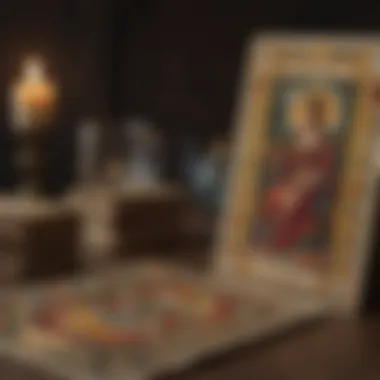
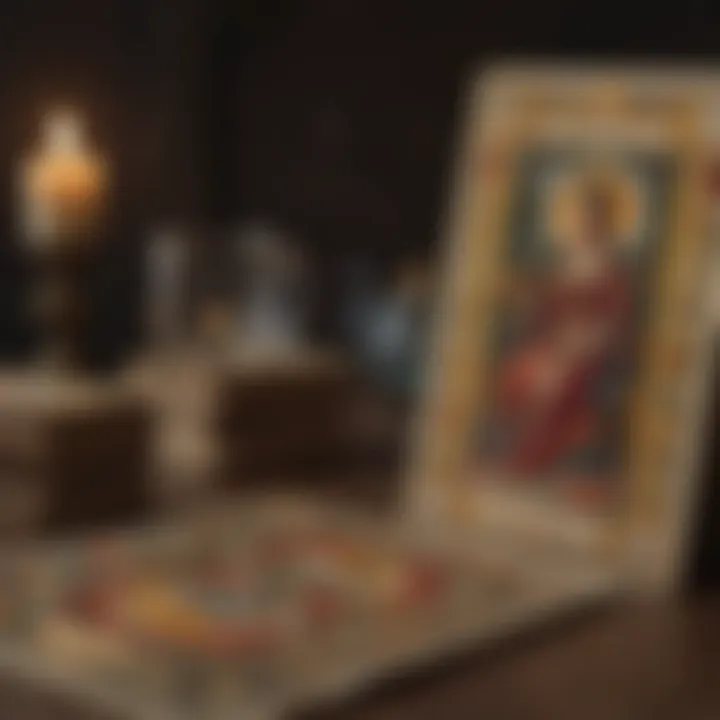
Intro
The Visconti Tarot represents a pivotal piece of history within the broader context of tarot. With its origins tracing back to the 15th century, this deck stands as a testament to the evolving practices of divination and insight. The intricate designs, rich symbolism, and cultural significance of the Visconti Tarot provide a comprehensive insight for both novice and seasoned tarot practitioners. In this exploration, we aim to unravel the layers that compose this historical deck, examining its impact on contemporary tarot reading and its relevance in modern spiritual practices.
Understanding the Zodiac
This section aims to bridge the concepts of astrology and tarot. The Zodiac serves as a foundational component in understanding personality traits and life influences, which can enhance tarot interpretations.
Overview of Zodiac Signs
The Zodiac consists of twelve signs, each representing different characteristics. Each sign corresponds to a specific time of the year and aligns with various celestial bodies. Understanding these signs can deepen the readings and insights derived from the Visconti Tarot.
Sign Traits and Characteristics
- Aries: Bold, energetic, and enthusiastic.
- Taurus: Practical, reliable, and sensual.
- Gemini: Adaptable, communicative, and curious.
- Cancer: Intuitive, nurturing, and emotional.
- Leo: Confident, charismatic, and dominant.
- Virgo: Analytical, careful, and detail-oriented.
- Libra: Balanced, social, and fair-minded.
- Scorpio: Passionate, intense, and transformative.
- Sagittarius: Adventurous, philosophical, and optimistic.
- Capricorn: Disciplined, responsible, and ambitious.
- Aquarius: Progressive, humanitarian, and inventive.
- Pisces: Compassionate, artistic, and dreamy.
Elemental Qualities
The signs are also categorized into four elements: Fire, Earth, Air, and Water. These elemental qualities influence the basic temperament and nature of each sign. Fire signs are dynamic and energetic, Earth signs are grounded and practical, Air signs are intellectual and communicative, while Water signs are emotional and intuitive.
Astrological Insights
Astrology and tarot can intertwine effectively. Understanding current astrological trends provides context for readings.
Current Astrological Trends
Astrological trends, such as the positioning of planets, can affect interpretations within tarot. Awareness of these trends can sharpen focus during readings, making them more pertinent to the querent's current life circumstances.
Influence of Celestial Events
Celestial events like eclipses and retrogrades can serve as catalysts for shifts in consciousness. Such moments can be analyzed alongside tarot spreads, enriching the insights gleaned from the Visconti Tarot.
How to Interpret Your Birth Chart
Understanding your birth chart can reveal personal development paths. This knowledge might assist in aligning tarot readings with broader life goals and challenges.
Horoscope and Predictions
Horoscopes provide ongoing insights that can complement the outcomes shown through tarot readings.
Monthly or Weekly Forecasts
Reading monthly or weekly forecasts can help practitioners make informed decisions in conjunction with their tarot practices. Calendar events may influence the vibrations around particular readings.
Personalized Horoscope Reading
Creating personalized horoscopes can provide tailored guidance that aligns with individual tarot journeys. Considering the unique aspects of one's natal chart connects deeper to the insights offered by tarot.
Compatibility Readings based on Zodiac signs
Compatibility between individuals can be assessed through their zodiac signs. This understanding may aid in providing direction in relational inquiries during tarot readings.
The intersection of tarot and astrology forms a multidimensional approach to divination, enriching the reader's experience and insight.
Historical Background of Visconti Tarot
Understanding the historical background of the Visconti Tarot is crucial to appreciating its significance in both historical and contemporary contexts. The Visconti Tarot is not just a set of cards but a reflection of the socio-cultural landscape of 15th-century Italy. Its origins provide insights into the practices of divination that have influenced modern tarot reading. Grasping the intricacies of its heritage allows tarot enthusiasts to connect deeper to the symbolism that the deck presents. This background sets the stage for a rich tapestry of meaning behind each card, paving the way for their application in today's spiritual practices.
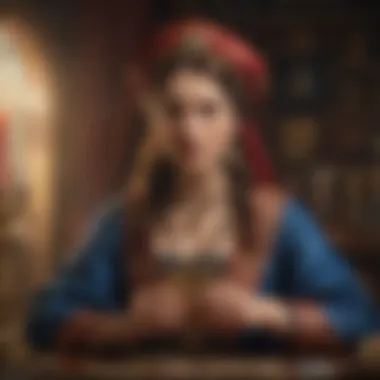
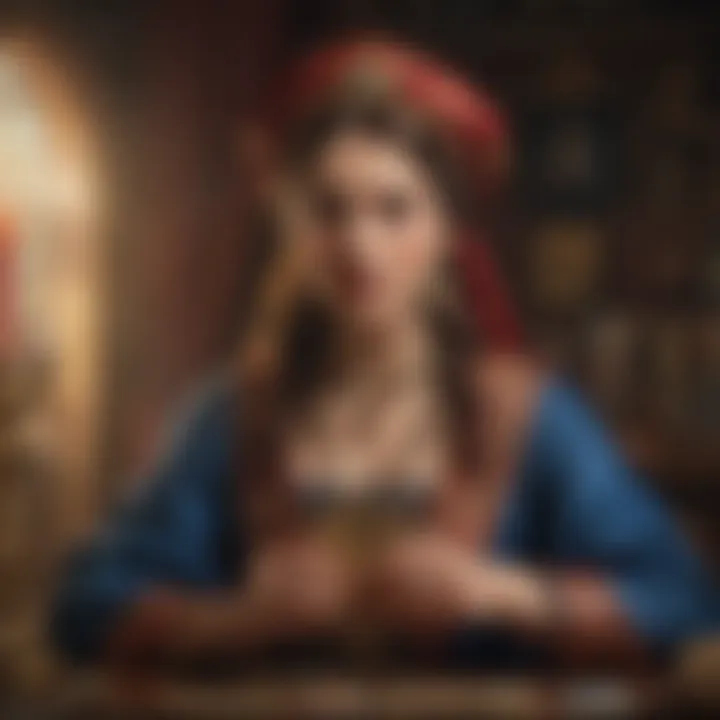
Origins in the 15th Century
The Visconti Tarot deck traces its roots back to the 15th century, a period characterized by a blend of artistic flourishing and intellectual awakening. This era saw the emergence of tarot as a form of card game and as a tool for divination. Initially, tarot cards served as a means for entertainment among nobles, but over time they adopted significant esoteric meanings. The Visconti deck, one of the oldest known, consists of beautifully illustrated cards that predate widespread standardization in tarot design. This deck predominantly used imagery influenced by the heraldry and symbolism of the time. A common assumption is that these cards were created for private use among the Visconti family, which reflects deeper meanings associated with lineage and status.
Connection to the Visconti Family
The Visconti family played an influential role in the governance and culture of Milan during the Renaissance. They were prominent figures who wielded considerable power, and their desire to project wealth and sophistication is evident in the aesthetic of the tarot deck. The connection to the Visconti family not only lends the deck its name but also encapsulates the narrative of Italian nobility. The cards, created by skilled artists, served as a testament to the family’s social standing. Each illustrated card resonates with symbols that echo the family’s heritage, political aspirations, and the artistic currents that defined Renaissance Italy. Familiarity with this lineage allows modern readers to appreciate the deeper personal meanings that can arise while interpreting the cards.
Cultural Context of Renaissance Italy
Renaissance Italy was a melting pot of innovation, where art intersected with philosophy and spirituality. It was during this transformative period that the Visconti Tarot emerged, reflecting these broader cultural currents. The deck embodies the synthesis of medieval traditions and humanist ideas, intertwining spiritual beliefs with emerging interest in the human experience. Tarot reading began to evolve as a practice beyond mere fortune-telling; it incorporated astrological and numerological elements that sought to provide insight into one’s life journey. This cultural backdrop highlights the complexity of each card and how they are informed by the societal values of their time.
"The Visconti Tarot acts as a historical record that informs the contemporary practices of tarot reading, providing a lens through which to view the evolution of divinatory arts."
The Visconti Tarot stands not only as a historical artifact but also as a vibrant element within the tapestry of tarot’s evolution. The layers of historical context enrich one's understanding, offering scholars, esotericists, and tarot readings a meaningful connection to the past.
Artistic Characteristics of Visconti Tarot
The artistic characteristics of the Visconti Tarot are not merely decorations; they are vital to understanding the essence of the cards. Illustrations created in the 15th century offer a unique glimpse into the cultural and societal values of the time. The rich artwork captivates the viewer, drawing connections to the personal and collective unconscious. Each card serves as a visual narrative, translating esoteric concepts into tangible images, thus enriching the practice of tarot reading.
Design Features and Aesthetic Choices
The design of the Visconti Tarot reflects the artistic styles prominent during the Renaissance. Lush detail characterizes each card, with intricate designs and human figures depicted in a naturalistic manner. This strays from more abstract tarot traditions. The use of gold leaf in some decks elevates the aesthetic experience.
The cards are not just tools but works of art that carry historical significance.
To help understand this better, consider these elements:
- Line Work: The flowing lines and careful detailing tell a story, portraying emotions and themes.
- Symbolism: Every element included in the designs contributes a layer of meaning, from flora to celestial bodies.
- Composition: The arrangement of figures within each card guides the viewer's focus, offering insights into the narrative.
The significance lies in how these aesthetic choices foster a deeper emotional and intellectual engagement when interpreting the cards. A reader can connect to the deck, spending time not only on the outcome of a spread but also on the imagery and history embedded in each card.
Color Palette and Symbolism
The color palette of the Visconti Tarot is rich and thoughtfully chosen. Each color conveys emotions and deeper meanings, influencing interpretations. Notably, the use of red often symbolizes power and passion, while blue evokes tranquility and wisdom. These choices are intentional, guiding the reader's intuition during a reading.
Furthermore, color interacts with symbolism in profound ways. For example:
- Green: Frequently associated with growth and prosperity.
- Gold: Reflects divinity, wealth, and enlightenment.
- Black and White: Represents duality, balance, and the eternal struggle between opposites.
The combination of colors and their symbolic meanings strengthens the tarot's role as a tool for insight. Each reading becomes not just a transaction of words but an exploration of emotional landscapes shaped by intuitive use of color.
Notable Cards and Their Significance
Some cards in the Visconti Tarot stand out due to their historical and symbolic depth. The Fool, depicted as a young man on a journey, symbolizes beginnings and potential. Similarly, the Empress echoes themes of fertility and creativity.
Noteworthy are these key cards:
- The Lovers: Represents union, duality, and choices in relationships.
- The Tower: Signifies upheaval, change, and the revelation of truth, often viewed with trepidation but also as a chance for rebirth.
- Death: Though intimidating, it signifies transformation, endings, and new beginnings, encouraging readers to embrace life's cycles.
These notable cards serve as focal points during readings, each carrying layered meanings that can unfold based on the question posed or circumstances surrounding the querent. Their significance underscores the need for a profound understanding of both the symbolism and the artistic choices that embody the essence of the Visconti Tarot.
Symbolism Embedded in the Visconti Tarot
Symbolism plays a pivotal role in the Visconti Tarot, revealing layers of meaning that go beyond visual aesthetics. Each card serves not only as a tool for divination but also as a reflection of historical and cultural contexts. Understanding these symbols can significantly enhance interpretations and readings within contemporary practices.
Major Arcana Explored
The Major Arcana consists of 22 cards, each representing archetypal themes and profound life lessons. For instance, the Fool suggests potential and new beginnings, while the Tower signifies upheaval. These are not merely images; they are distilled wisdom encapsulated in symbolism. Studying the Major Arcana reveals how each card’s symbols interact with human experiences.
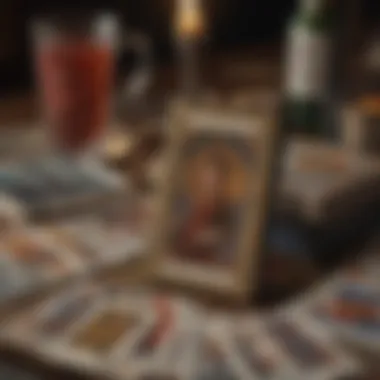
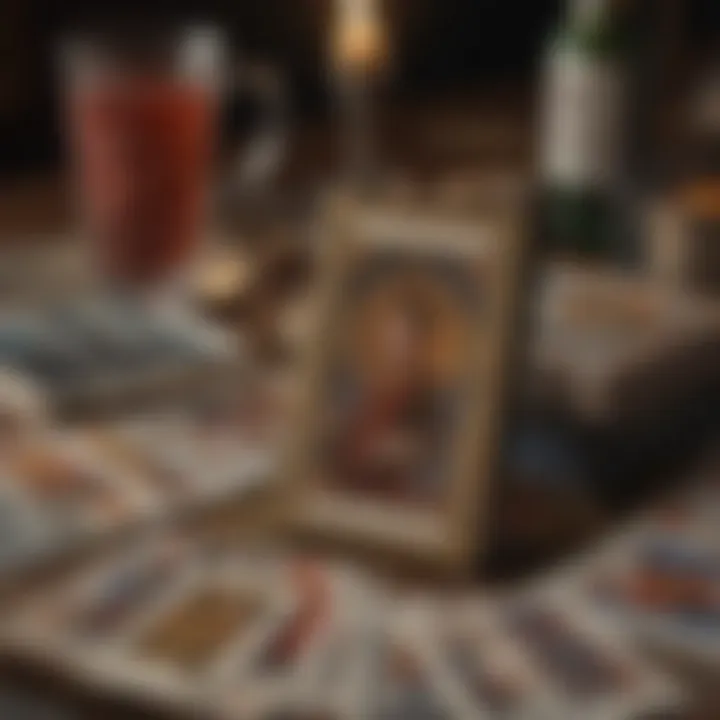
- The Fool: Represents spontaneity and adventure, often capturing the essence of new journeys.
- The Magician: Symbolizes skill, resourcefulness, and power of manifestation.
- The Lovers: Indicates duality, choice, and harmonious unions.
Understanding these meanings allows readers to draw connections between the cards and their life contexts, enhancing the usefulness of readings.
Minor Arcana Insights
The Minor Arcana, divided into four suits, reflects everyday experiences and challenges. Each suit corresponds to specific life aspects:
- Cups: Associated with emotions and relationships.
- Swords: Signifying conflicts and intellectual challenges.
- Wands: Representing inspiration and willpower.
- Coins: Tied to material concerns and physicality.
The individual cards within these suits further elaborate on these themes. For instance, the Three of Cups frequently denotes celebration while the Five of Swords points to conflict. Readers benefit from a nuanced understanding of these meanings to facilitate more accurate readings.
Connections to Astrology and Numerology
Astrology and numerology are often intertwined with tarot. Each card can correspond to astrological signs and houses, enriching its interpretation.
- Astrology: For example, The Chariot relates to Cancer. This framework adds depth, linking universal astrological themes with personal narratives.
- Numerology: Each card number has intrinsic meaning. The number 7 is often related to introspection and spiritual growth.
By understanding these correlations, practitioners can provide deeper insights during readings, creating a richer experience for querents.
Ultimately, the symbolism within the Visconti Tarot is a gateway to understanding both individual experiences and collective archetypes, enriching the practice of tarot reading in both historical and modern contexts.
Techniques for Reading the Visconti Tarot
Reading the Visconti Tarot involves more than just understanding the cards; it requires an appreciation of the historical context, symbolism, and reading techniques. These approaches can enable both seasoned practitioners and novices to unlock deeper layers of meaning in their tarot readings.
Basic Spread Techniques
Basic spread techniques serve as building blocks for anyone looking to work with the Visconti Tarot. These spreads provide a structured way to interpret the cards and often lead to insightful revelations.
Common Basic Spreads:
- Three-Card Spread: This simple layout allows for a quick analysis of past, present, and future influences. Each card represents different timeframes or aspects of a single question.
- Celtic Cross: More complex, this ten-card spread provides a detailed look at various influences surrounding a situation or a person's life. It allows for a comprehensive overview, each position having its own specific meaning.
- One-Card Draw: Ideal for getting quick insights or guidance on daily issues, pulling one card can provide clarity and focus.
The value of these basic spreads lies in their flexibility and interpretative potential. Each technique keeps the reader grounded while exploring multifaceted meanings. Beginners should practice these simple spreads regularly to develop their intuition and familiarity with the specific cards.
Advanced Interpretation Methods
Once the foundations are established, advanced interpretation methods provide deeper insights for those wanting to elevate their tarot practice. These techniques encourage a more nuanced approach, allowing practitioners to enrich their readings significantly.
Strategies for Advanced Interpretations:
- Combining Cards: Understanding the relationships between cards in a spread can reveal layered meanings. For example, placing the Temperance card next to the Tower may suggest a need for balance in times of upheaval.
- Intuitive Readings: Learning to trust one's intuition can create a more personal and authentic reading experience. This requires practice in setting aside preconceived notions about card meanings.
- Contextual Considerations: Tailoring interpretations based on the querent’s circumstances or the broader context can enhance understanding. Consider personal factors, current events, or emotional states in conjunction with the cards drawn.
- Symbolism Analysis: Deepening the focus on specific symbols in the Visconti Tarot can reveal unique insights. Look for recurring motifs across the cards and consider their significance in retrospect to questions or situations.
Encouraging practitioners to experiment with these techniques can yield transformative experiences. Advanced methods enable a more personalized and profound connection with the Visconti Tarot, promoting both introspection and revelation.
The mastery of tarot reading lies in the balance between structured technique and intuitive insight.
By integrating both basic and advanced techniques, anyone can deepen their tarot practice, whether for personal reflection or professional consultation.
Modern Applications of Visconti Tarot
The Visconti Tarot holds enduring significance in the realm of tarot today. Its applications extend beyond mere historical interest and have become vital in contemporary practices. By exploring the modern uses of the Visconti Tarot, we can understand its relevance in the evolving landscape of tarot reading. The practices have transformed, but the deck’s insights remain profoundly relevant, offering depth in both individual and collective contexts.
Role in Contemporary Tarot Practices
The Visconti Tarot is not just an artifact; it is a living tool in modern tarot reading. Many practitioners incorporate this deck into their sessions due to its rich symbolism and historical context. For starters, the unique imagery from the 15th century provides a different perspective compared to more recent decks. Each card invites introspection and dialogue, making it an excellent choice for both novice and experienced readers.
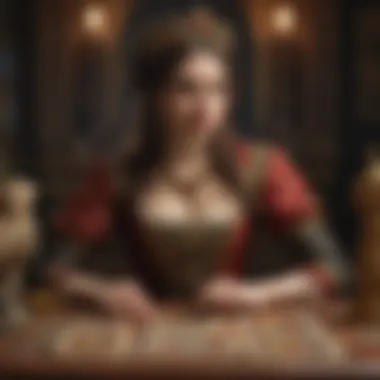
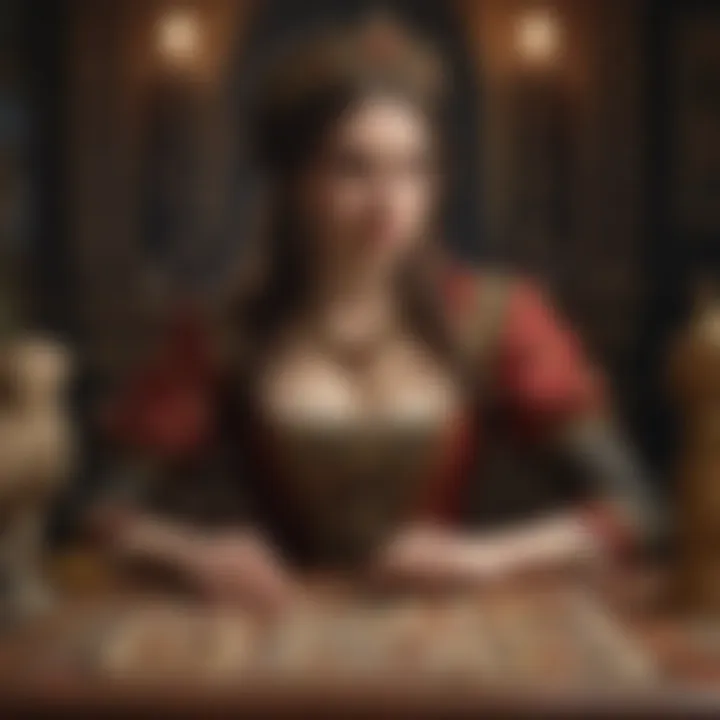
- Deep Insight: The artwork stimulates deeper inquiries when interpreting meanings. The visuals often evoke emotions and memories.
- Historical Connection: Readers appreciate the link to the past as they engage with a piece of history. It allows them to connect with the traditions that shaped tarot.
- Flexibility in Readings: The Visconti Tarot can adapt to various reading techniques. Whether one uses three-card spreads or Celtic crosses, the deck remains effective.
The Visconti Tarot encourages readers to embrace an exploratory mindset. It is not just about predictions; it invites contemplation and deeper understanding of the self and the universe.
Integration with Modern Spirituality
Modern spirituality often emphasizes personal growth and self-awareness. The Visconti Tarot integrates seamlessly into this framework. Many practitioners find the symbolism within its cards aligns well with contemporary spiritual beliefs.
- Self-Reflection: The imagery inspires self-reflection and inner work. Readers often use the cards to delve into personal challenges, aspirations, and relationships.
- Ritual Practices: Many use the deck in spiritual rituals or as part of meditative practices. The cards' historical resonance adds weight to spiritual pursuits, enriching the experience.
- Community Engagement: Online platforms for sharing tarot experiences have blossomed. The Visconti Tarot is frequently discussed, analyzed, and celebrated across these platforms, enhancing its community's collective understanding.
The Visconti Tarot’s blend of history and symbolism offers spiritual seekers a poignant lens through which to explore their journeys.
Collecting and Preserving Visconti Tarot
Collecting and preserving the Visconti Tarot is a vital subject for enthusiasts and curators alike. These decks not only hold artistic value but also represent a significant historical narrative that enriches the understanding of tarot as a whole.
Historically, the Visconti Tarot decks are among the oldest known tarot cards, coming from the 15th century. They offer insights into the aesthetics, culture, and philosophical ideas of their time. Collecting such decks allows individuals to connect deeply with history, gaining a firsthand experience of the cultural influences that shaped tarot's evolution. Each deck carries its own story, representing the family’s lineage and the social context of Renaissance Italy.
In addition, preserving these decks ensures that future generations can study and appreciate their significance. Effective preservation techniques involve appropriate storage methods, controlled environments, and careful handling to prevent wear and tear. Collectors should invest in archival-quality materials and consider exposure to light, humidity, and temperature fluctuations.
Benefits of Collecting and Preserving Visconti Tarot:
- Understanding historical context
- Enriching personal tarot practices
- Gaining appreciation for art and design
- Contributing to cultural heritage
Considerations for Collectors:
- Authenticity and provenance of decks
- Maintenance and preservation standards
- Engagement with community and knowledge exchange
Influence of the Visconti Tarot in Popular Culture
The Visconti Tarot holds a significant position within popular culture, transcending its original purpose as merely a tool for divination. Its striking imagery and rich history have inspired various forms of creative expression. Throughout literature, art, and film, the Visconti Tarot resonates as an influential force, depicting themes of fate, choice, and the human condition. The deck's blend of historical authenticity with potent symbolism serves as a bridge between the esoteric and the artistic, appealing to both enthusiasts and casual observers alike.
Visconti Tarot in Literature and Art
The impact of the Visconti Tarot in literature can be observed through numerous examples where tarot cards symbolize broader concepts. Various authors have referenced or incorporated the Visconti Tarot motifs in their narratives, often to explore the interplay of destiny and personal agency. These literary works not only serve to illustrate the power of tarot but also integrate its symbolism within broader philosophical discussions.
Artistic reflections of the Visconti Tarot are equally compelling. Many contemporary artists draw on its imagery, blending it with modern styles. By doing so, they instill new meanings into the classic designs while ensuring the historical context is respected. For instance, exhibitions featuring reimagined Visconti cards highlight the eternal relevance of these archetypes. This engagement with the past enriches both the viewer's experience and their understanding of the symbolism embedded in the artwork.
Cinematic References and Interpretations
Cinema has also embraced the Visconti Tarot, utilizing its distinct imagery to evoke themes of fate and introspection. Films often depict characters using tarot as a means to navigate their journeys or illuminate their psyches. Such representations frequently serve as pivotal plot devices or motifs, underlining the influence of tarot in contemporary storytelling. Some filmmakers even integrate specific Visconti cards, showcasing them in a manner that emphasizes their profound meanings.
The integration of Visconti imagery in film highlights its role as a cultural artifact, bridging the gap between past and present.
Additionally, documentaries and movies that explore the world of tarot often engage with the Visconti Tarot as a centerpiece. These explorations provide insight into not just the cards themselves, but also the broader cultural implications of tarot reading through the centuries. This context serves to cement the deck’s legacy within the collective consciousness and illustrates its impact on modern spirituality.
Epilogue: The Timeless Nature of Visconti Tarot
The Visconti Tarot stands as a significant artifact, transcending time and culture. It is not only a reflection of the 15th-century society but also resonates with contemporary audiences. Understanding its importance means recognizing the layers of historical relevance and modern applications that continue to thrive. The Visconti Tarot offers unique insights into destiny, emotional awareness, and spiritual connections.
Reflection on Historical and Modern Relevance
The historical context of the Visconti Tarot is rich. Its creation during the Renaissance provided a physical representation of the cultural and artistic movements of that time. By engaging with this deck, one taps into the beliefs and ideologies that shaped its creation. This tarot deck holds significance beyond its time of origin; it links the past with the present, serving as a bridge between tradition and innovation.
In modern tarot practices, the Visconti Tarot is often seen as a starting point. Many practitioners regard its artistic style and symbolism as fundamental to understanding the evolution of tarot itself. The connection of the deck to the Visconti family adds another layer of intrigue. It provides insights into nobility, power, and spirituality, which remain relevant in discussions of authority and self-identity today. Whether one is looking for personal insights or broader societal interpretations, the lessons from the Visconti Tarot are timeless.
Encouragement for Further Exploration
Diving deeper into the Visconti Tarot offers a chance to explore complex themes and ideas. Practitioners are encouraged to study the cards, paying attention to the nuanced imagery and details. Each card holds its own significance, representing various life themes, struggles, and triumphs. Engaging with this deck can enhance one's understanding of both tarot and personal experiences.
Several resources exist to aid in this exploration:
- Books on Tarot History - Many authors focus on the evolution of tarot and its interpretations across cultures.
- Online Forums - Websites like reddit.com host communities discussing tarot and its applications.
- Art Analysis - Investigating the artistic elements within the cards can yield deeper insights into their meanings.
In summary, the Visconti Tarot is not merely a set of cards; it is a dialogue between the past and future. For those interested in astrology, esotericism, or personal growth, this deck serves as both a tool and a canvas, encouraging ongoing exploration and insight.







